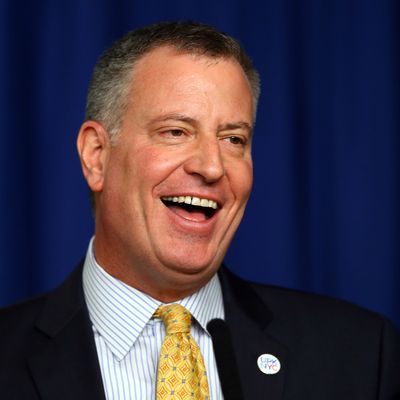
Today Mayor Bill de Blasio unveiled a major cornerstone of his agenda, a housing plan that doesn’t simply try to add thousands of apartments but pursues his progressive social vision. The plan is full of eye-popping numbers: 200,000 new or preserved “affordable” housing units over the next decade. More than $8 billion in city spending and tax breaks. A 50 percent cut in the time spent gaining land use approval.
It’s an ambitious attack on a pernicious problem — the galloping cost of rents and mortgages. But what’s most striking about the plan isn’t the large numbers of apartments or dollars. It’s that by launching such a far-reaching program, instead of focusing on a narrower list of goals, de Blasio has ensured himself hundreds of political fights trying to make it happen.
Tackling a multifaceted issue with a broad range of tactics is both realistic — as one of de Blasio’s top deputies said in a press briefing this morning, “there are no magic bullets” — and admirable. Yet some of the mayor’s choices, both in substance and strategy, guarantee he’s in for a messy slog.
The City Council, for instance, has already beaten back a mayoral attempt to streamline the labyrinthine zoning approval process — because individual council members would have had to surrender power over what gets built in their districts. On the one hand, that’s the kind of grassroots democracy de Blasio celebrates; on the other, it promises headaches when he proposes building specific projects in specific neighborhoods.
Then there’s the money. The city’s billions in capital spending for housing will come at the expense of other categories in the larger budget, which is to be revealed later this week. “That’s why the labor contracts are so important,” a mayoral insider told me. “De Blasio knows he can’t do all these good progressive things if he’s spending all the money on unions.” Holding the teachers and other municipal workers to modest raises still leaves a gap, however. De Blasio’s plan anticipates needing an additional $1.9 billion, during the next ten years, primarily from federal and state sources who aren’t exactly flush.
Or take one of the bigger surprises from today’s announcement. De Blasio was expected to adopt mandatory inclusionary zoning — that is, any private housing developer receiving city funds would be required to set aside a significant percentage of units that would rent below market rates. The mayor does indeed want mandatory inclusionary zoning—but he’s commissioning a study that may take another year, to try to tailor the percentages to individual re-zonings. Flexibility is good — it just means de Blasio’s team will need to work even harder to hit its targets.
And some of the mayor’s proposed cures for income inequality — especially his emphasis on subsidizing housing for lower income instead of middle-class families — will be criticized as ensuring that New York is two cities instead of three. To foster “inclusive neighborhoods,” de Blasio’s plan is generous to seniors, the homeless, and families of four making less than $67,000 annually. Just 22 percent of the affordable units are devoted to families with “moderate” and “middle” incomes — from $67,000 to $138,000. One element of the formula — increased “density” — will stoke controversy if the mayor intends to construct taller towers in gentrified neighborhoods.
De Blasio has hired some skilled lieutenants to design and implement his housing ideas, chief among them Alicia Glen, his deputy mayor for Housing and Economic Development and a former top executive at Goldman Sachs. Some of the complexities facing Glen and her team could be seen right down the street from the mayor’s press conference in Fort Greene this morning. More than ten years after Atlantic Yards was announced, the Nets are in the playoffs, but not a single unit of housing — affordable or otherwise — has opened on the site. And the project’s developer is back at City Hall seeking more taxpayer subsidies.
De Blasio, thankfully, isn’t suggesting another stadium-anchored housing complex, though his plan does mention building atop other, unspecified railyards. Still, for all the big numbers and big ideas in the housing plan, probably the wisest thing the mayor and his top deputies did today was ask for patience.





























